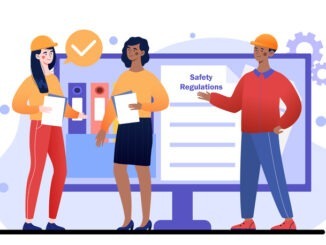
In this day and age, many jobs require the use of DSE for all parts of the working day – here’s a guide to what a DSE assessment is and why you should have one
CREDIT: This is an edited version of an article that originally appeared on Work Happy
A DSE Assessment is a legal requirement under the Health & Safety Regulations 1992. Anyone who uses screens at work for an hour or more each day must have one.
DSE Assessments may also be referred to as a ‘Workstation Assessments’ or ‘VDU (Visual Display Unit) Assessments’ and are designed to flag up any issues related to your use of screens at work.
For example, your screen may be set at a height that could cause back problems for you in the future. A DSE Assessment would find this problem and help you and your employer to rectify it before long-term damage is done.
A DSE Assessment covers more than just the way you use screens – it also covers your workstation set-up in general and is purely based on your personal wellbeing. Therefore, an assessment will also include looking at what you’re sitting on, your keyboard and mouse, the lighting, and the environment around you in general.
There are three main components to a DSE Assessment:
Training & information
This may be in the form of advice about posture, instructing an employee on small desk exercises to mitigate potential problems, resources to look back on, and educating general good practice.
Assessment of risks
This can be done in person or via a video call with the employee. The assessor will look at the whole workstation, which includes any and all equipment being used, the suitability of desks and chairs, and the general work conditions (temperature, noise pollution, lighting, electrical safety, etc.). The employee’s role will be taken into account, as well as any special requirements they may have.
Management of risks
Any potential problems that come up during the assessment are managed via things like employee training, on-site massage, provision of eye-tests and ergonomic equipment/supports, upgrading office furniture and being encouraged to move around more during a working day.
Of course, how you feel personally about your working environment and any issues you experience are the most important things, so it’s vital that you are open and honest about aches and pains, eyesight issues or any other workstation-related problem you may experience.
For those who sit at a desk and look at a computer for practically all of their working day, DSE Assessments should be a familiar and welcome event. If you have never had a DSE Assessment in your current role, you should request one as soon as you can.
Why do I need a DSE Assessment?
Health
The wellbeing of employees is what DSE Assessments are all about. We know that long-term use of a badly set-up workstation will cause both short- and long-term issues for the individual employee.
Some of the most common issues experienced by desk workers include lower back pain, eye strain, and neck strain, as well as hip and wrist issues. These problems are not always obvious right away, and someone could work in a damaging posture for years before pain presented itself.
Stress and fatigue can also arise from a poor workstation set-up, which in turn can affect our immune system’s response to colds and other illnesses.
Moving around and stretching during the working day is something that is likely to come up during a DSE Assessment. This is because sitting (or standing) in the same position whilst staring at a screen for long periods of time will put a strain on your body.
Doing this repeatedly day after day does have an accumulative effect, and employers who do not provide – and follow-up on – regular DSE Assessments are likely to experience considerably more sick leave within their organisation than their DSE compliant peers.
Law
Compliance with the law is also a key part of providing DSE Assessments. Under the Health and Safety (Display Screen Equipment) Regulations 1992, employers can be fined by the Health and Safety Executive for not complying.
In addition to this, they may also be litigated against by current or previous employees on an individual basis, as long-term injuries may not present themselves for some time. If DSE Regulations have not been adhered to, this could result in high legal expenses and settlements.
There are also similar regulations around the world so keep this in mind if you plan on working abroad.
How Often Should I Have A DSE Assessment?
As a rule, a DSE Assessment should be completed as soon as possible after each of the following:
- When a new employee starts work
- When an employee moves to a new workstation
- When office furniture and devices are upgraded or replaced
- If an employee has a change in physical circumstances (e.g. pregnant worker or sports injury.)
- When an employee reports concerns about their workstation
Or
- At least every 2 years (as advised by The Royal Society for the Prevention of Accidents)
Many companies do yearly DSE Assessments for all qualifying staff members to ensure full compliance, and we would also recommend yearly testing as a minimum.
These assessments can be overlooked, and it’s important that all employers are aware that regular DSE Assessments are an essential undertaking. Only providing DSE Assessments for new starters or when an employee has requested one is not suitable or lawful, and could leave the employer open to fines or lawsuits in the future.
DSE Assessments should be provided for all employees who use DSE for an hour or more each day; whether they work in an office, work from home, or work whilst on the move.
What are the benefits of DSE Assessments?
For the employee
- Improves posture
- Improves general wellbeing at work
- Boosts productivity morale
- Prevention of future injury and musculoskeletal disorders
- Makes work easier to concentrate on/complete
- Special requirements are met, which boosts inclusivity
For the employer
- Reduced sick-leave costs due to work-related injuries or illness
- Reduced admin costs
- Fewer compensation claims
- Happier workforce
- More productive workforce
- Full compliance with the law
We hope this article has proven helpful. You can find out more about an online DSE assessment here, a virtual (video) assessment here, or an in-person ergonomic assessment here.



Be the first to comment